
The Spanish market potential for fresh fruit and vegetables
Spain is Europe’s leading agricultural producer. Nevertheless, imports from developing countries have grown exponentially over the last five years. Rising internal demand, the country’s growing role as a trader, and the arrival of purchase centres of large European retail chains in Spain all contribute to this growing need for imports. Exporters can find major opportunities for products such as avocados, berries, mangoes, pineapples, oranges and grapes.
Contents of this page
1. Country description
Spain is the largest producer of fruit and vegetables in Europe and holds a strategic location in southern Europe. This also makes it an attractive hub for major trade routes and a gateway to other European countries.
Source: Eurostat
With a Gross Domestic Product (GDP) of $1.4 trillion, Spain is the 4th largest economy in the European Union (EU) and the 14th worldwide. The purchasing power per inhabitant is just below European average but there are large regional differences.
With 48 million residents, its large domestic market makes Spain an appealing destination for fruit and vegetable exporters. In addition, Spain received 85 million visitors in 2023, enlarging the domestic market. Spain expects to reach 90 million visitors in the coming years.
In 2023 the Spanish ports moved 11.9 million tonnes of fruit and vegetables, 7% more than in 2022. Almost half of this (5.4 million tonnes) was destined for national consumption. The rest was re-exported to other European countries. Algeciras and Valencia are the most common ports for fresh fruit and vegetables and moved most of the total fresh produce volume.
The official language in Spain is Spanish, and speaking it is an advantage. Many buyers might not speak English or have even a basic understanding. There are other recognised regional languages such as Catalan and Basque. These are not needed to do international business.
Keep in mind that Spain is a country with many regional differences, and doing business in one region does not guarantee that it will be the same in another or that you will have national coverage. In general, building a relationship beyond business is important for Spanish buyers.
Tips:
- Visit websites such as businessculture.org and the Cultural Atlas to read more about doing business in Spain.
- Many figures and trend reports are only available in Spanish. Use the translation option in your browser to explore the websites in Spanish that are referenced in this study.
2. What makes Spain an interesting market for fresh fruit and vegetables?
Spain’s dominant role in the fresh sector as a longtime producer and lately as an emerging trader, has translated into rising imports over the last years. Developing countries are key suppliers, and their participation in the market is expected to increase.
An up-and-coming importer to complement domestic supply
Spain is the 5th largest fruit and vegetables producer worldwide, and the largest in Europe. About a quarter of all fruit and vegetable production in the EU is cultivated in Spain, with 29% for fruit and 20% for vegetables.
Source: European Statistics Handbook, Fruit Logistica 2024
With 323 kg per household, Spain ranks first in terms of the purchased volume of fresh fruit and vegetables in Europe. Maintaining a healthy and varied diet is the main reason Spaniards eat fresh fruit and vegetables, which continue to be the most bought fresh items in supermarkets.
Despite its extensive production capacity, Spain needs to import fruit and vegetables to meet this demand. Spain is also the main supplier of fruit and vegetables within the European market (Table 1), and increasingly wants to secure a continuous supply for partners abroad. Over the past years, producing companies from Spain have imported more fresh produce to offer a year-round supply to their customers. Moreover, large European buying groups have set up purchase centres in Spain to source both locally and from abroad.
Table 1: Top 5 Suppliers in intra-European trade of fruit and vegetables in 2023, in € million
| Supplier | Fruits | Vegetables | Total |
| Spain | 8,434 | 7,520 | 15,955 |
| Netherlands | 6,536 | 7,122 | 13,659 |
| Italy | 2,950 | 1,869 | 4,819 |
| France | 1,338 | 2,561 | 3,899 |
| Belgium | 2,059 | 1,217 | 3,277 |
Source: ITC Trade Map, June 2024
In 2023, 97% of the fruit and vegetable exports from Spain went to Europe. Germany, France, and the United Kingdom were the leading importers, together accounting for nearly 60% of the export value. Spain’s strategic position, boosted by its robust connectivity through the Atlantic and Mediterranean Corridors, has strengthened its role as a vital trading hub for fruit and vegetables.
Spain’s role as a trader has grown over the last years and the country is becoming more professional both in terms of installed capacity and staff. Technological improvements have enabled more efficient management of the supply chain, including improvements in cold storage facilities. Entering the business are more staff of a newer generation that speak better English and are trained for trading and negotiating. Unlike the Dutch who have been trading for a long time, Spain is still in its infancy as trade liberalisation started in the late 1950s.
Imports from developing countries are rising
Spain is the 5th largest European importer of fresh fruit and vegetables from developing countries. Most imports are fruit, accounting for 76% of the total value. In 2023, imported values of fresh fruit and vegetables grew by 23% to reach €2.6 billion. The largest importer was the Netherlands with a value of €4.5 billion, followed by Germany (€4 billion), the United Kingdom (€3.6 billion) and France (€3.3 billion).
Among those top five importers, Spain had the largest growth rate both in the last year and between 2019 and 2023. Spanish imports of fresh produce from developing countries grew at a rate of 55% over the 2019-2023 period (60% in fruits and 37% in vegetables), compared to 9% in the Netherlands, 20% in Germany, 5% in the United Kingdom, and 50% in France. This growth is expected to continue over the next years, with Spanish companies increasingly becoming re-exporters and climate change threatening internal and European production.
Source: ITC Trade Map, June 2024
The main non-European suppliers are Morocco, Peru, Costa Rica, Brazil, South Africa, and Colombia. Morocco adds to the Spanish season by supplying products such as berries, beans, tomatoes and avocados. Egypt has grown in importance and mainly exports oranges to Spain. Peru, Costa Rica, Brazil, South Africa and Colombia fill in the gaps with counter-seasonal products like avocados, grapes, asparagus, citrus and tropical fruit.
Spain has experienced extreme drought and enormous heat over the past 3 years. This has affected the cultivation of fruit and vegetables, including stone fruit, soft fruit such as strawberries and melons, and citrus. In addition, rising production costs are making production less profitable. This overall uncertainty of the future of cultivation of fruit and vegetables in Spain offers even more opportunities for exporters from developing countries.
Tips:
- Follow the development of the Spanish market by reading the news on portals such as Fruitnet, Freshplaza, FruiTrop, and FreshFruitPortal.
- Attend Fruit Attraction in Madrid in October. It is the leading fresh fruit and vegetables trade fair in Spain and one of the most important fresh produce trade fairs in Europe.
3. Which fresh fruits and vegetables offer the most opportunities in the Spanish market?
Imports from developing countries mainly consist of a few products that have grown at high rates over the past five years. Avocados, berries (blueberries and raspberries), pineapples, oranges, mangoes and grapes offer the most opportunities.
Bananas are the most imported product after avocados, but the market is very traditional with limited room for new origins. Green beans, tomatoes and peppers are also relevant import products, but imports are concentrated in Morocco, with limited potential for the introduction of new origins. Melons are also relevant with Brazil, Morocco and Senegal as the main suppliers. However, the rapid growth of grapes makes them more interesting to focus on in this study.
Table 2: Products imported by Spain from developing countries, sorted by import value in 2023, in € million
| Product code | Product | 2019 | 2020 | 2021 | 2022 | 2023 | 1 year growth 2022 vs 2023 | 5 year growth 2019-2023 |
| 080440 | Fresh or dried avocados | 244 | 296 | 350 | 342 | 430 | 26% | 76% |
| 080390 | Fresh or dried bananas (excluding plantains) | 179 | 163 | 188 | 241 | 291 | 21% | 63% |
| 081020 | Fresh raspberries, blackberries, mulberries and loganberries | 181 | 167 | 152 | 186 | 212 | 14% | 17% |
| 081040 | Fresh cranberries, bilberries and other fruits of the genus Vaccinium | 96 | 129 | 158 | 187 | 183 | -2% | 90% |
| 080430 | Fresh or dried pineapples | 104 | 92 | 101 | 123 | 146 | 19% | 40% |
| 080510 | Fresh or dried oranges | 52 | 67 | 65 | 58 | 143 | 146% | 177% |
| 070820 | Fresh or chilled beans "Vigna spp., Phaseolus spp.", shelled or unshelled | 139 | 127 | 125 | 119 | 142 | 20% | 2% |
| 080450 | Fresh or dried guavas, mangoes and mangosteens | 94 | 97 | 99 | 106 | 138 | 30% | 47% |
| 070960 | Fresh or chilled fruits of the genus Capsicum or Pimenta | 63 | 62 | 64 | 86 | 98 | 14% | 56% |
| 070200 | Tomatoes, fresh or chilled | 66 | 79 | 84 | 93 | 86 | -7% | 29% |
| 080719 | Fresh melons (excluding watermelons) | 62 | 64 | 66 | 57 | 85 | 49% | 36% |
| 080610 | Fresh grapes | 40 | 54 | 74 | 64 | 83 | 29% | 105% |
Avocados
Spain ranks as the 4th largest importer of avocados globally and the 3rd largest in Europe. Between 2019 and 2023, total avocado imports grew 69% in value and 77% in volume, reaching €516 million in 2023. Peru and Morocco are the main and fastest-growing suppliers to Spain. Import values more than doubled for Peru and more than tripled for Morocco over the last five years. Other suppliers include Chile, Colombia, Mexico, and Kenya.
Source: ITC Trade Map, June 2024
The global and European trend of increasing avocado consumption has also been clear in Spain. This surge is primarily fuelled by a growing demand for health-conscious products and the incorporation of more natural foods into daily diets.
A survey conducted by the World Organization of Avocado (WAO) highlights Spain as the leading consumer of avocados in Europe, with an average of 1.3 avocados per week. The survey also reveals that the average weekly consumption across Europe is nearly one avocado per week, with France following at 0.9 and Germany at 0.6. Other studies estimate a yearly per-capita consumption of 1.8 kilos of avocado. According to the data available, avocado consumption in Spain skyrocketed in 2017 and has not stopped growing to date.
Spain is also a grower of avocados. Many producers of traditional Spanish crops such as cherimoya, citrus and medlar have chosen to grow avocados instead. However, the bulk of the supply is imported, highlighting a substantial market potential for exporters from developing countries. Official data shows that in 2022, avocado production decreased by 10% to 106,500 tonnes. In the same year, Spain imported 208.6 million tonnes and exported 149,700 tonnes. The main destinations of avocados traded by Spain are France, Germany and the Netherlands.
Adverse climate conditions, water scarcity and rising production costs threaten to continue to reduce the avocado production in Spain. Andalusia, which is the main producing region, has experienced a decrease in production due to drought. This situation opens up further opportunities for producers from developing countries, mainly in Latin America and Africa. Suppliers from Morocco are attractive for Spanish producers to extend the local season. Peru is the main supplier in the off-season between March and October. Other suppliers such as Chile, Colombia, Mexico and Kenya prefer to enter when the Peruvian season is low or over.
To make use of the opportunities, producers need to pay attention to maximum residue levels (MRLs), but also find ways to differentiate themselves in the market. Although at a lower level than in Northern European markets such as Germany, organic and sustainable farming practices are more and more demanded to resonate with Spanish consumers' growing preference for environmentally-friendly products. Also, as the Spanish role as a hub for demanding markets is growing, so are the requirements.
Reyes Gutierrez is an example of a Spanish producer, exporter and importer based in Malaga. They import and export avocados from all over the world and have strict quality controls including organic and social certifications.
Figure 5: Avocados in different packaging at a supermarket in Madrid
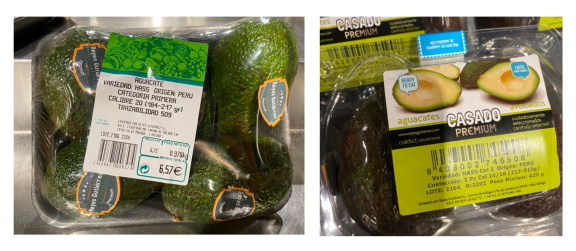
Source: Dana Chahin
The Spanish market for organic avocados
In 2023, Spain was the largest European importer of organic avocados. The latest available data from TRACES shows that imported volumes almost doubled between 2019 and 2023, as Spain went from importing 6,895 tonnes in 2019 to 18,836 tonnes in 2023. The main supplier of organic avocados in 2023 was Peru with 50% of the total imported volume, followed by Kenya (32%) and Morocco (9%).
As of May 2023, Alimarket analysis estimated for Spain a yearly market size for organic fruits of 16,471 tonnes. Avocados accounted for 8% of that volume (1,285 tonnes), after bananas (44%) and apples (24%). This data implies that most of the organic avocados imported into Spain are re-exported to other European countries, which is in line with the growing role of Spain as a hub and the increasing presence of purchase centres of German retailers in Spain.
Tips:
- Check our study on avocados to further understand the dynamics in the European market.
- Make sure to find the right timing to enter the market, so that you do not end up competing in an oversupplied market. This article gives you an overview of the avocado supply windows worldwide.
- For a full reference study about production, consumption and trade statistics of the Spanish food and fresh produce industry, read this report (in Spanish) published by Mercasa (the Spanish wholesalers network) every year.
Berries
Despite having local production, Spain imports a large portion of its berries. Berry imports into Spain increased by 43% between 2019 and 2023, reaching €517 million in 2023. The growth rate between 2022 and 2023 was 11.3%. The products included in the berry category include raspberries, cranberries, blueberries, strawberries, blackberries and currants. However, almost half (48%) of the imports are berries of the Vaccinium genus (mainly blueberries). Raspberries account for a further 33%.
In the 2023/2024 campaign, Spanish imports of berries revealed a clear preference for sourcing strawberries and raspberries from within the EU. By contrast, blueberries are predominantly imported from non-EU countries (Figure 6). For this reason, blueberries offer exporters from developing countries the most opportunities in the berries category.
Source: Ministerio de Agricultura, Pesca y Alimentación, 2023
Morocco is the primary supplier of berries to Spain, mainly exporting raspberries and blueberries. There are also some minimal exports of strawberries. The 2nd largest supplier from a developing country is Peru, with 88% of the volume of berry exports being blueberries. South Africa is also a relevant player, supplying blueberries to Spain. Its exports to Spain more than doubled in value and almost doubled in volume between 2022 and 2023.
Although Morocco is expected to continue being the most relevant supplier of berries to Spain and Europe, the effects of high temperatures and drought have significantly reduced local production that had been on the rise for a decade. Therefore, the uncertainty of a continuous supply might affect prices in the coming future. However, Morocco is not the only country affected by climatic conditions. Peru and Chile have also faced a decline in production levels due to meteorological conditions in recent seasons.
The trend towards organic produce is particularly pronounced in the berry segment, and Spanish consumers increasingly seek out sustainably sourced and ethically-produced options. However, this mainly applies to local products. The organic production of berries in Spain has increased over the past years. In 2022, there were about 1,800 hectares of organic production. For exporters from developing countries, it might be more challenging to find buyers in the organic segment, but there is demand for sustainable farming methods.
Tips:
- See our study on fresh blueberries for more detailed insights into the European market for fresh blueberries.
- Visit the website of potential buyers of berries to get familiar with their standards and origins. Examples are Ideal Fruits and Surexport.
Pineapple
Spain has a limited production of pineapples in the Canary Islands. With consumption consistently rising over the past five years, the country imports most of its pineapples from developing countries. This has positioned Spain as the largest import market for pineapples from developing countries since 2022 (overtaking the Netherlands, which was leading until 2021). In 2023 imports reached €150 million and 180,813 tonnes. The growth rate compared to the previous year was 16% in value and 19% in volume.
Source: ITC Trade Map, June 2024
The main country of origin is Costa Rica (90%), but there are growing opportunities for other countries. Panama, Ecuador, Ivory Coast, and Kenya have also entered the market, be it with lower quantities. South Africa and Mauritius export baby pineapples, but quantities are small and have decreased over the past years.
African exporters of pineapples have opportunities to expand their presence in the Spanish pineapple market. Africa’s market share has expanded from 0.7% in 2019 to 2.3% in 2022 and 1.2% in 2023.
Internal consumption has experienced a shift in preference towards high-quality pineapples. This has been possible due to an improvement of the purchasing power of Spanish households and a stabilisation of pineapple prices. The consumption of green pineapples was dominant some years ago, but it has been declining in recent years. By contrast, demand for coloured pineapples has been stable and there is an increasing presence in supermarkets.
Figure 8: Pineapples at supermarkets in Spain (ready to eat, imported by air, ripened on the plant)
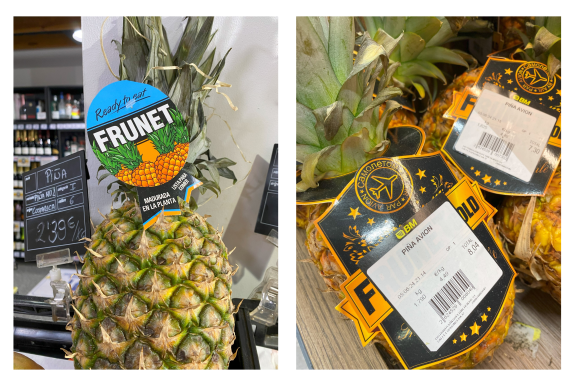
Source: Dana Chahin
Although there are some exports, most of the pineapples imported into Spain are going to the domestic market. There is a year-round demand, with a clear peak in December for the Christmas season. Spanish consumers look for ready-to-eat and ripened pineapples, which makes Spain a large market for air-freighted pineapples. If pineapples are imported by air, this is often stated in the label as a sign of freshness. Frunet, a Spanish importer of tropical fruit, markets its pineapples with the value proposition “ripened on the plant” and “ready to eat”.
Spanish companies such as Cultivar are leaders in the commercialisation of premium pineapples in supermarkets. Their brand EXOTICA PREMIUM focuses exclusively on best-quality pineapples from selected origins which include Costa Rica, Ecuador, Brazil and Ivory Coast.
Tips:
- Read our study on pineapples to better understand the European pineapple market.
- Check the pineapple brands of leading Spanish importers of pineapples. Cultivar’s brand EXOTICA PREMIUM, for example, focuses exclusively on best quality pineapples from selected origins which include Costa Rica, Ecuador, Brazil and Ivory Coast.
Oranges
Spain is the main citrus production country and a leading exporter not only to Europe but to countries around the world. Oranges are both the most produced and most exported fruit in the citrus category, which comprises lemons, smaller citrus fruits like mandarins, and pomelos. In the 2022/2023 seasons, Spain produced 2.8 million tonnes of oranges. Valencia and Andalucia are the main growing regions.
At the end of the 2024 season, Spanish producers complained about the low-priced and lower-quality oranges from Egypt in the European and local market. This was not isolated to this season, as there is a natural tension between Spanish producers and their competitors from developing countries. At the same time though, Spanish producers and importers are increasingly looking for cooperation opportunities with other orange-supplying countries. Their goal is to use their distribution network to provide oranges all year round and not only during the Spanish season.
Imports have experienced significant growth, and this is expected to continue over the next years. Spain went from importing 148,549 tonnes in 2019 to 227,834 tonnes in 2023. The main supplier in volumes in 2023 was Egypt with 109,152 tonnes, followed by South Africa with 54,620 tonnes.
In values, South Africa was the main supplier, which reflects the lower prices of the oranges from Egypt. The imported unit value of South Africa was 1,156 €/tonnes, while for Egypt it was 529 €/tonnes (less than half). Other non-European suppliers were Argentina, Zimbabwe and Uruguay which exhibited similar unit values to South Africa (1,047 €/tonnes for Argentina, 1,038 €/tonnes for Zimbabwe, and 1,028 €/tonnes for Uruguay).
Tips:
- Follow the developments of the orange market worldwide by reading the regularly updated market overviews of Fresh Plaza.
- Check the websites of leading citrus cooperatives in Spain such as Anecoop to understand their structure and leading role in the market.
Mango
Spain is the leading European mango producer and the 4th largest import market from developing countries in Europe. Imported values and volumes have steadily grown in the last five years, reaching €138 million and 80,931 tonnes in 2023. Internal consumption has also grown rapidly, and in Mercamadrid mango was the 2nd fastest-growing subtropical fruit of the decade lasting from 2012 to2022 after avocado.
This makes Spain an attractive destination, which has also gained importance as a hub to reach other European countries. In 2023, exports reached 42,819 tonnes and exports were exclusively intra-European, except for sales to Morocco (in 4th place). France, Germany and Italy were the main export partners of Spain.
The main suppliers of mangoes to Spain are Brazil, Peru, Mexico, Dominican Republic, Ivory Coast, and Colombia (Figure 9). Burkina Faso, South Africa and Senegal have also managed to consistently export over the past five years. There is increasing interest in mangoes from Egypt as well. Air-freighted mango is common in Spain, mainly from Peru, Brazil, and Mexico. However, the prices for air-freighted mangoes are rising, which makes selling sea-freighted mangoes easier. In the long term, demand for air-freighted mangoes will likely decrease, not only because of prices but also for sustainability reasons.
Source: ITC Trade Map, June 2024
62% of the Spanish mango production is concentrated in the province of Malaga. In 2022, production reached 39,944 tonnes. Osteen is the most common variety and production happens between August and September. Many producers import mango to cover the off-season, which is why many of your potential buyers are also located in this province. Many companies have specialised in the production and commercialisation of avocado and mango. Some examples include Trops, Axarfruit and Reyes Gutierrez (also mentioned in the section above for avocado).
Figure 10: Mangoes from Ivory Coast at a Spanish supermarket
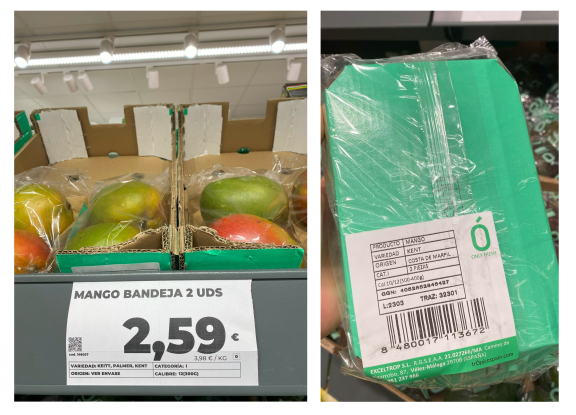
Source: Dana Chahin
Tip:
- Read our study on mangoes to better understand the European mango market.
Table grapes
Spain is the 2nd-largest producer of table grapes after Italy. In 2023, Italy produced 910,000 tonnes, followed by Spain with 331,000 tonnes and Greece with 250,000 tonnes. Spain produces mainly white and red varieties, both with seeds and seedless. Production has increased over the last five years, but exports and imports have also risen. This makes Spain an attractive market as a growing European hub with strong internal consumption.
Imports from developing countries have more than doubled in value, with a growth of 105% between 2019 and 2023. Volumes have also experienced sustained growth: in 2019 Spain imported 19,115 tonnes from developing countries and in 2023 the volumes reached 34,687 tonnes. This is about 6% of total EU imports of table grapes from developing countries.
Peru is the largest supplier of grapes to Spain, representing almost 36% of the total import volume. Italy and Chile come next with market shares of 24% and 18%, respectively. Brazil, South Africa, the Netherlands and Morocco complete the list of the six top suppliers. Other developing countries such as Egypt, India, Moldova and Namibia have also grown over the years. Egypt, in particular, went from supplying 148 tonnes in 2019 to 678 tonnes in 2023, showing sustained growth throughout the last five years.
Figure 11: Seedless (sin pepita) grapes from Chile in Spanish supermarkets
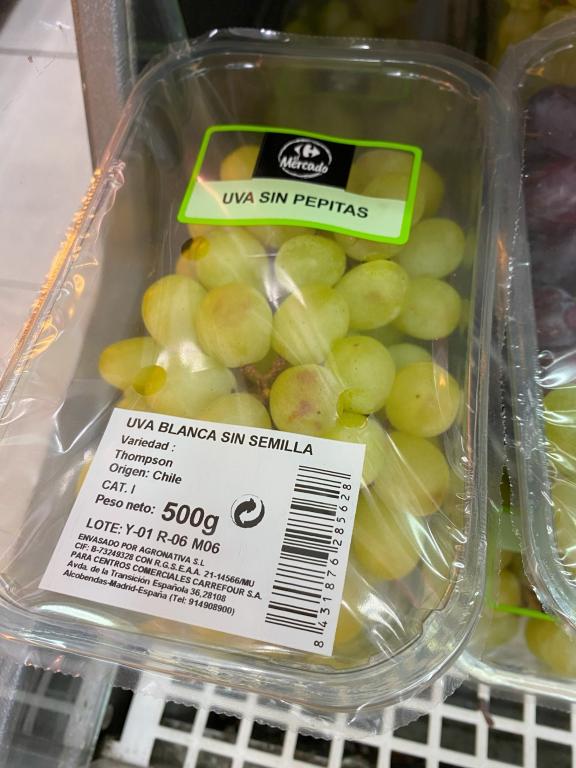
Source: Dana Chahin
Tip:
- Read our study on table grapes to better understand the European table grapes market.
4. Which trends offer opportunities or pose threats in the Spanish fresh fruit and vegetables market?
In Spain, price highly determines the purchase of fresh products. Finding the perfect balance between quality and price is key to successfully entering the market. Sustainability is gaining importance and although standards are not as strict as in Northern European countries, the increasing role of Spain as a trade hub in Europe is raising the bar even more. Preference for local and regional products is high. Therefore, you should place your product on the market during the off-season to avoid competing with local produce.
Perfect balance between price and quality
Price is still the determining factor when buying fresh products in Spain. A study conducted by ALDI (in the Spanish language) found that half of Spanish consumers consider the price when purchasing fresh produce, and 9 out of 10 consumers consider it a decisive factor. Another study by GfK (in Spanish), found that in 2023, 47.7% of households cited price as the main reason for not consuming fresh fruits and vegetables more often, a significant increase from 17.6% in 2022.
Aspects such as the quality and appearance of a product have been gaining importance over the past years. According to the same ALDI study referenced above, these two criteria are among the top 5 considered by shoppers when purchasing fresh produce. The price-quality relation is also an important factor when deciding to buy fresh products: in 2024, 57% of Spanish consumers bought fresh products in the supermarket because of this.
Convenience motivates consumption
Besides price and quality, convenience is also an important factor holding back consumers from buying fresh fruit and vegetables. According to the same GfK study cited above, convenience is the second most important reason to have a low consumption frequency of fresh fruit and vegetables. In 2023, 39.2% of consumers cited convenience as a reason, compared to 37% in 2022. The high/medium-high socioeconomic level segment and women are those who gave the most importance to convenience (45.0% and 41.7% respectively).
Consumers find it inconvenient to have to peel and prepare fruit and vegetables, which has caused an upsurge in convenience options. Convenience products are becoming more affordable and popular, in part because of a competitive pricing landscape at supermarkets. Constant innovation by Spanish producers and importers for convenience products creates opportunities for suppliers from developing countries, especially for lower-category fruit (good inside but with a bad appearance).
Examples of such companies in Spain include Bonnysa and Verdifresh. These clients will usually source the whole fruit and re-package it at their own location. Imported products that are more often offered as convenience are avocados, pomegranates, coconuts, and pineapples. To access these opportunities, make sure that your product’s taste and inside quality are excellent.
Figure 12: Aisle of convenience fruit at a Spanish supermarket
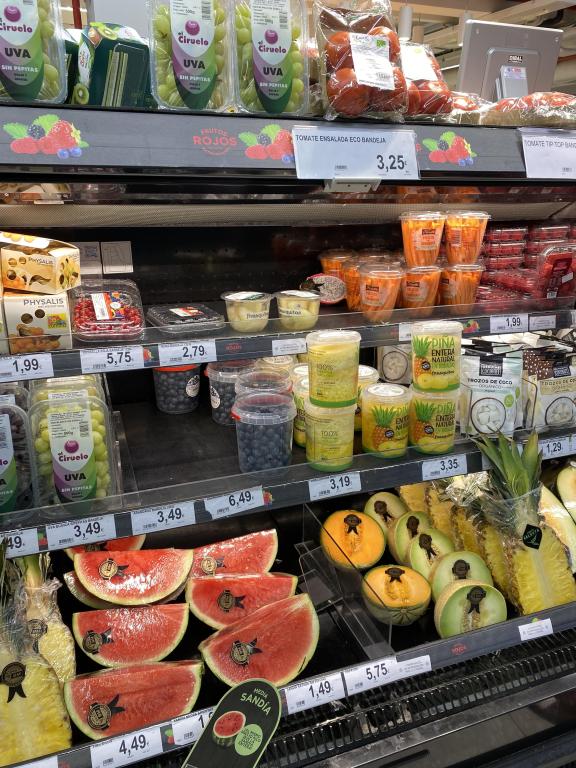
Source: Dana Chahin
Sustainably produced and sourced is gaining importance
It is widely known that Northern European countries are at the forefront of sustainability. Spain is already somewhat on board with this trend. A younger generation of Spanish consumers is increasingly demanding sustainably sourced and ethically produced fresh fruit and vegetables. As in the rest of Europe, this is driven by growing concerns about health and increasing environmental and social awareness.
Moreover, with Spain becoming a trade hub in Europe, sustainability standards are demanded more and more by importers that re-export to other European markets or sell to supermarket chains that need to maintain the same standards across Europe. For Spanish consumers, sustainability certifications are not a highly-valued measure of sustainability (Figure 13). This is why, unless they focus on one of the above-mentioned end-markets, Spanish importers are not as demanding in terms of sustainability certifications as their counterparts in other European markets.
In contrast, sustainable packaging is gaining importance among consumers in Spain. In 2024, around a third of Spaniards valued the reduction of plastic in the packaging of fresh products (28%) as a sustainability measure. This shows an increase of 3 percentage points from last year. Other sustainability measures such as sustainable farming and sustainability throughout the entire value chain are also valued by a fifth of consumers (Figure 13).
To capitalise on the opportunities resulting from this trend, exporting companies from developing countries need to highlight their sustainability initiatives in their value proposition, and ideally back them up with certifications. This is what allows your clients to ensure their clients (supermarkets or other end-market segments) that they are sourcing sustainably along the entire value chain.
Source: ALDI Observatory of Fresh Produce, 2024
There is a small organic import market focused on importers trading abroad
In 2021, the area dedicated to organic production in Spain grew by 8% compared to the previous year, reaching 2,635,442 hectares. This means that 10.8% of Spain's utilised agricultural area is dedicated to organic production. Spain has the 2nd largest area of organic farmland in Europe and is the 3rd in number of producers, only after Italy and France.
Based on data from FiBL, the share of retail organic sales in Spain is estimated at 2.5%, compared with shares of 7% in Germany, 6.6% in France, 3.4% in Italy, and 3.3% in the Netherlands. The demand for organic products is expected to grow with forecasts of a Compound Annual Growth Rate (CAGR) of 4% from 2021 to 2026.
Also based on FiBL data, the number of organic importers in Spain in 2021 was 472, compared to 2,016 in Germany, 662 in France, 579 in Italy, 533 in the Netherlands and 520 in Switzerland. By contrast, Spain has many organic exporters (230) in comparison to other European countries. Only Italy and Poland exceed Spain with 1,036 and 319. This shows the focus of the Spanish organic sector on the export market, rather than their own domestic market.
The figures above show that despite showing signs of growing, Spain is not the most attractive market for organic imported products in Europe. Most organic product campaigns are for local products and the expected growth in demand will most likely be covered by domestic produce. With the exception of European central purchase centres or Spanish importers that sell to European markets with a more mature and fast-growing organic market, the opportunities for organic are limited. Examples of such clients are Axarfruit or Campiña Verde Ecosol S.L.(part of the German REWE Group).
Most opportunities will be found by suppliers of organic avocados, where Spain is a leading importer. Goshen Farm Exporters from Kenya is a grower and exporter of avocados that has successfully tapped into the Spanish market. Goshen has both organic and conventional fruit which is certified by GLOBALG.A.P. and GRASP. Its regular attendance at leading trade fairs in Europe, including Fruit Attraction in Madrid, and its participation in the IPD Programme have been key to networking and being prepared to sell to clients in Spain.
Strong preference for local and regional products
With Spain being a large producer of fresh fruit and vegetables, consumers are used to buying local and seasonal products. Local products are seen as fresher, tastier and having a better price-quality ratio. In general, Spanish people like to support local agriculture, and there is a long-standing tradition of using fresh ingredients in the preparation of local dishes. For younger generations, the environmental factor plays an increasingly important role in the preference for local and regional products. Long-distance transport is associated with a larger carbon footprint.
Many supermarkets emphasise their investments, commitments and efforts to buy more from local growers in their corporate strategies. The supermarket chain DIA, for example, will invest over €30 million in purchasing summer fruit exclusively from Spanish suppliers. And ALDI communicates that more than 65% of the fruit and more than 85% of the vegetables offered at their supermarkets are of Spanish origin.
Despite this strong preference for local and regional products, there are opportunities for exporters from developing countries. Spanish people have been exposed to new local products that were previously not produced in Europe. Some years ago, for example, avocado was not a common product in the shopping baskets of Spanish households. With the rise in local production, this is now a product that most Spaniards buy on a regular basis. But this would not be possible without a combination of domestic and international supply.
Tip:
- If your product is also produced in Spain, find the right window to supply the market. Do not try to export your product when there is local produce on the shelves.
Dana Chahin carried out this study on behalf of CBI.
Please review our market information disclaimer.
Search
Enter search terms to find market research
